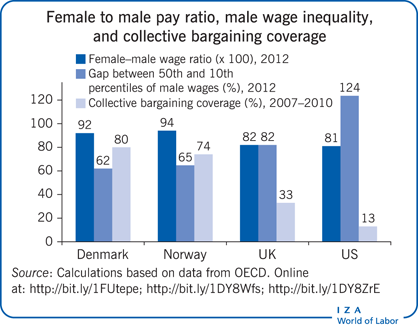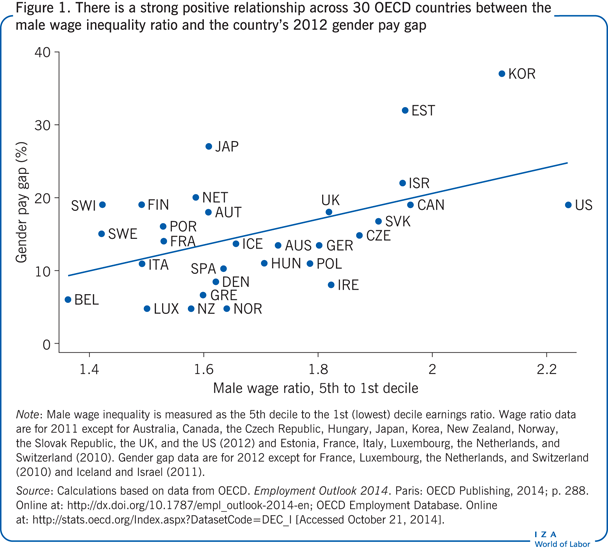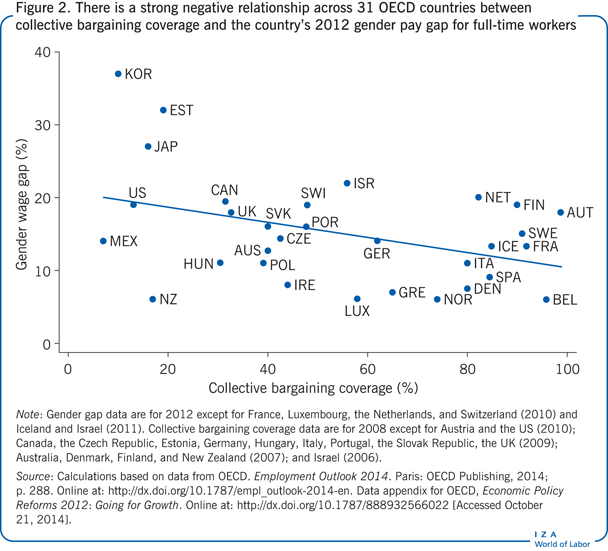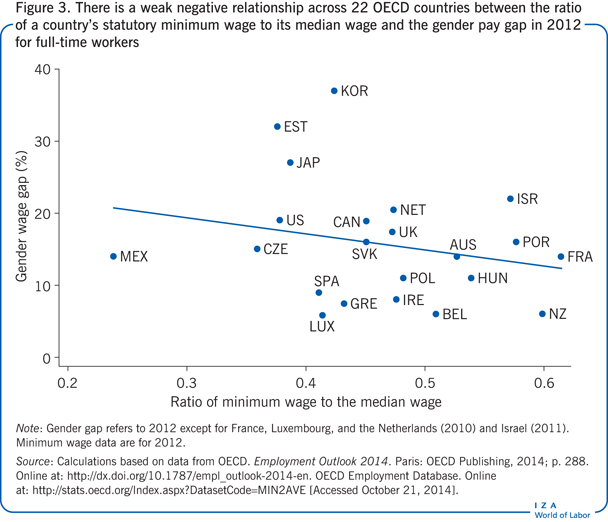Elevator pitch
There are large international differences in the gender pay gap. In some developed countries in 2010–2012, women were close to earnings parity with men, while in others large gaps remained. Since women and men have different average levels of education and experience and commonly work in different industries and occupations, multiple factors can influence the gender pay gap. Among them are skill supply and demand, unions, and minimum wages, which influence the economywide wage returns to education, experience, and occupational wage differentials. Systems of wage compression narrow the gender pay gap but may also lower demand for female workers.

Key findings
Pros
Wage-setting institutions that compress wages at the bottom of the distribution disproportionately raise the wages of low-paid workers, reducing inequality.
Wage compression raises women’s wages by more than men’s because women are more likely to be at the bottom of the distribution.
Wage floors can reduce exploitation of low-wage workers and enhance economic efficiency.
Cons
Reducing wage differentials based on skill may adversely affect an economy’s resource allocation by reducing workers’ incentives to acquire skills.
Low-wage workers, such as women, may experience employment losses as a result of wage floors.
Reducing occupational wage differentials may reduce women’s incentives to enter male-dominated occupations and thus contribute to the continuation of occupational segregation by gender.
If wage-setting institutions affect unemployment, they may also affect the sample used in measuring the gender wage gap.
Author's main message
Understanding the gender pay gap can help in evaluating labor market efficiency. Wage-setting institutions such as collective bargaining and minimum wages typically lift the bottom of the pay distribution, disproportionately raising women’s pay but also leading to adverse employment effects. Pay systems that compress occupational wage differentials can reduce women’s incentives to enter male-dominated occupations and may lower workers’ incentives to acquire skills. Policies to reduce occupational gender segregation and career interruptions by women may narrow the gender pay gap without the adverse employment effects of wage compression.
Motivation
As of 2010–2012, of 31 OECD countries with data, the gender pay gap ranged from only 6% in Belgium, Luxembourg, New Zealand, and Norway to 27% in Japan, 32% in Estonia, and 37% in South Korea. Understanding the causes of the gender pay gap, including international differences in the gap, can help in evaluating the efficiency of the labor market. For example, if women earn less than comparably productive men because of discrimination, the gender pay gap may reflect a labor market inefficiency in that women’s abilities are not being fully applied in the labor market.
Gender pay gaps are one example of wage differentials. Countries also differ greatly in the degree of wage compression generally. For instance, as of 2010–2012, men at the median of the wage distribution earned 49–53% more than those at the 10th percentile in France, Norway, and Portugal, but 124% more in the US. At the same time, wage-setting institutions were vastly different across countries. For example, worker coverage by collective bargaining as of 2007–2010 ranged from 10–20% in Estonia, Japan, South Korea, New Zealand, and the US to 90–99% in Austria, Belgium, France, Finland, and Sweden. Moreover, most industrialized countries have statutory minimum wages, which in 2012 ranged from 36–38% of the median wage in the Czech Republic, Estonia, and the US to 58–62% of the median in France, New Zealand, and Portugal. In addition, in several countries, unions negotiate sectoral or economywide minimum wage standards even if there is no formal statutory minimum wage. Minimum wage statutes and sectoral collective bargaining contracts affect wage inequality generally. Moreover, since men and women are located in different parts of the wage distribution, these institutions may indirectly affect the gender pay gap as well [1], [2].
In all industrialized countries, there is a large degree of occupational segregation by gender, and women are usually more likely than men to have interrupted work careers and to work part-time. However, differences in wage-setting institutions imply that the wage consequences of gender differences in labor market commitment and occupational representation are not the same in different countries; moreover, supply and demand factors can affect these wage differentials as well. Of course, wage differentials are not the only outcome affected by these institutions. For example, systems of pay compression, by changing relative prices in the labor market, also change firm incentives to hire and train workers, as well as worker incentives to enter the labor market and to acquire human capital. These changes in relative prices, by changing incentives, may then lead to changes in the overall efficiency of the labor market. A country with a small gender pay gap may have especially productive women relative to men or a wage structure that does not permit large wage differentials. An evaluation of the impact of a gender pay gap, then, depends on its sources. International comparisons of institutions and wages structures can be a fruitful avenue for studying these issues.
Discussion of pros and cons
Wage structure and the gender pay gap: Conceptual issues
Much research on the gender pay gap focuses on gender differences in qualifications, experience, or treatment by firms. These factors may be thought of as gender specific in that male–female differences in these dimensions cause a gender pay gap. In addition, men and women work in a world economy in which labor market prices such as the returns to education or experience are affected by supply and demand as well as labor market institutions. Moreover, since men and women work in different industries and occupations, differences or changes in occupational or industrial wage differentials will lead to differences or changes in the gender pay gap as well. This constellation of returns to skills and to location in favorable sectors of the economy is referred to here as the “wage structure.”
A key insight on intergroup wage differentials, which was originally applied in an analysis of racial disparities in wage in the US, is that the overall wage structure can affect the relative wages of specific groups [3]. For example, countries with strong unions that raise the wages of less-skilled workers tend to have a fairly compressed wage structure, while countries like the US, where wages are determined in a more decentralized manner, tend to have a more dispersed wage structure.
Changes in the wage structure are likely to have an effect on the gender pay gap. For example, in the 1980s in the US, the return to experience rose, as did wage premia for specific occupations. Since women have less experience than men and are in lower-paying occupations, these changes in the wage structure worked against a narrowing of the gender pay gap. Despite the increase in labor market returns in the US, however, the gender pay gap narrowed since women improved their qualifications enough to outweigh the adverse effects of changes in wage structure [4].
While overall labor market prices will affect the gender pay gap, some of the underlying factors affecting the return to skills in the US in the 1980s changed in ways that favored women. For example, manufacturing employment fell relative to other sectors, and within sectors blue-collar employment fell relative to white-collar employment. Since men are more likely than women to be employed in manufacturing and in blue-collar jobs, these economywiDEvelopments served to narrow the gender pay gap [4].
While supply and demand can affect the returns to skills and occupational or industrial wage differentials, institutions can affect these returns as well. The most prominent of these are minimum wage laws and collective bargaining. Higher minimum wages necessarily affect the bottom of the pay distribution, where women are disproportionately located. Sectoral collective bargaining agreements typically call for wage floors set by industry or even across industries and thus also disproportionately raise the wages of low-paid workers, again more likely to be women than men [1].
Perhaps working in the opposite direction to wage floors is employment protection for those in permanent employment (as compared with temporary or contractual employment). In many European countries, it is very expensive to fire permanent employees, while restrictions on firing workers in temporary jobs are much lighter. In countries with strong employment protection laws, workers in permanent jobs would be expected to have enhanced bargaining power due to the high costs of firing workers. Since women are less likely than men to be employed in permanent jobs, this kind of protection could widen the gender pay gap. This widening effect is reinforced since laws mandating high firing costs from permanent jobs likely increase the share of temporary jobs, which pay less and are disproportionately staffed by women [5].
If firms are allowed to determine the level of employment, then high wage floors would be expected to reduce the quantity of labor demanded. Since women are more likely to be on the lower end of the wage distribution, such negative employment effects would be expected to be stronger for women. These employment effects are an important potential downside of wage-setting arrangements that raise the floor and thus reduce wage inequality generally and that between men and women specifically.
Empirical evidence on wage compression and the gender pay gap
Cross-country comparisons
To see the connection between wage compression and the gender pay gap, it is instructive to compare the contrasting cases of Denmark, Finland, Norway, and Sweden with Canada, the UK, and the US. For example, in 2012, women’s pay averaged 88% of men’s pay in the Scandinavian countries, but only 81% of men’s pay in the three English-speaking countries. Moreover, in 2011–2012, men at the median earned 54% more than men at the 10th percentile in the Scandinavian countries, in contrast to a 101% gap in the English-speaking countries. And during 2007–2010, 84% of workers in Scandinavian countries were covered by collective bargaining, in contrast to only 26% in Canada, the UK, and the US. Although Scandinavian countries did not have statutory minimum wages (and Canada, the UK, and the US did), unions in the Scandinavian countries negotiated sectoral agreements, which have the effect of wage floors. Scandinavian countries and the English-speaking countries seem at opposite poles in their labor market institutions and outcomes, and these comparisons suggest an inverse relationship between collective bargaining and wage compression on the one hand and the gender pay gap on the other.
Figures 1–3 show that these comparisons between Scandinavian countries and the three English-speaking countries reflect a general pattern relating wage compression and the gender pay gap that is not simply specific to these countries. Figure 1 shows a statistically strong positive relationship across 30 OECD countries between the ratio of full-time male wages at the fifth decile relative to the first (lowest) decile and the country’s 2012 gender pay gap. Excluding the extreme case of Korea still yields a statistically strong positive relationship. Compression is measured using male wage inequality rather than overall wage inequality in order to avoid a mechanical relationship between inequality and the gender pay gap. While the relationship between the ratio of male wages at the ninth decile and at the fifth decile and the gender pay gap was also positive, it was not as strong and was not statistically significant. It is thus inequality at the bottom that matters for the gender pay gap, underscoring the importance of wage floors.

Figures 2 and 3 show negative relationships between institutions that impose wage floors and the gender pay gap. Figure 2 shows that the 2012 gender pay gap is strongly significant and negatively associated with the fraction of the country’s workers covered by collective bargaining. Figure 3 shows that the gender pay gap is negatively associated with a country’s statutory minimum wage relative to its median wage, although the effect is only slightly larger than its standard error. As was the case in Figure 1, excluding Korea does not alter these overall conclusions.


Microeconometric evidence
While Figures 1–3 suggest that wage compression overall narrows the gender pay gap, the data do not control for other factors that could affect the gender gap. The impact of wage compression on the gender pay gap has been studied formally, however, in research that examines international differences and within-country changes in the gender pay gap. Much of this research uses methods developed in [3] to study changes over time in wage differentials between black and white workers in the US. To examine the gender pay gap, these studies use microdata to distinguish differences or changes in the gender pay gap that are gender-specific (such as gender differences in labor market experience) and those that are related to the overall wage structure (such as differences in the return to being in high-paying industries).
Using microdata enables studies to control for differences between men and women in education or experience, for example. One study that contrasts the US female–male pay differential in the late 1980s with the gender gap in several other countries (Australia, Austria, West Germany, Hungary, Italy, Norway, Sweden, Switzerland, and the UK) finds that the gender pay gap was about six percentage points lower, on average, in the other countries than in the US [1]. However, US women’s observed characteristics were usually superior to those of women in the other countries, and the average US woman placed at a higher point in the distribution of male wages than women in the other countries did. But counteracting these gender-specific advantages for US women was the much greater overall wage compression in the other countries. The smaller variation in wages overall in those countries was sufficient to account for the entire difference between the gender pay gap in the US and that in other countries. International differences in wage-setting institutions such as collective bargaining are a likely part of the explanation.
Additional evidence on the impact of the wage structure and wage-setting institutions on the gender pay gap comes from a comparison of the gender pay gap in Australia and Canada in 1989–1990 [6]. Specifically, the gender gap in hourly wages was lower in Australia than in Canada. Between 35% and 64% of this difference was found to be caused by Australia’s more compressed wage structure, which was likely to be strongly influenced by the more extensive coverage by collective bargaining in Australia than in Canada.
Episodic changes in wage-setting institutions
In some instances, countries’ labor market institutions change dramatically. Such events create the conditions for a natural experiment and thus provide opportunities to study the impact of the overall wage structure on the gender pay gap. For example, in Sweden between 1968 and 1974, unions aggressively pursued a policy of reducing wage differentials, particularly at the bottom of the wage distribution. One study found that this wage compression caused Sweden’s gender pay gap to narrow [7]. A study of the changing gender pay gap in Denmark over 1983–1995 noted that during these years, Denmark’s wage setting became less centralized [8]. The study found that the gender pay gap rose and that the increasing dispersion of the overall wage structure accounted for most of the widening of the gender pay gap.
One of the most dramatic changes in labor market structure over the last 25 years has been the fall of communism. In former Soviet Bloc countries and in China, highly centralized wage-setting mechanisms were replaced by decentralized, market-oriented wage-setting arrangements. Wage dispersion increased in these countries, and studies of changes in the gender pay gap found that these changes in wage structure widened the gender pay gap. For example, one study found such effects for the Czech Republic, Hungary, Poland, Russia, the Slovak Republic, and Ukraine [9]. In addition, the gender pay gap in China widened from 1988 to 2004, a period of decentralization and increased wage dispersion [10].
Wage compression and the gender pay gap: Beyond individual country comparisons
The studies discussed so far use two-country comparisons or individual comparisons over time to infer the impact of wage structure on the gender pay gap. However, a study using microdata for 22 countries over 1985–1994 directly estimated the impact of male wage compression on the gender pay gap. [11]. The study measured wage compression by computing male wage inequality after adjusting for the distribution of measured personal characteristics, in order to focus on prices in the labor market. It found that, overall, a higher level of male wage compression narrows the gender pay gap; in addition, all else being equal, a higher supply of women relative to the demand for women implied by a country’s industrial structure widens the gender pay gap. Like Figure 2, this study finds that higher levels of collective bargaining coverage narrow the gender pay gap, providing further evidence that wage-setting institutions that compress the wage structure overall also reduce the gender pay gap.
Just as with collective bargaining, minimum wages raise the wage floor and thus disproportionately affect female workers. One study did a simulation of the impact of the falling real value of the US minimum wage between 1979 and 1988 on the gender pay gap [4]. It found that if the minimum wage had maintained its 1979 real value, the gender pay gap would have fallen about 1.6 percentage points more than its actual reduction of about 16 percentage points. Not surprisingly, the effect was larger for lower-skilled women than for higher-skilled ones. International comparison finds that the gender pay gap during 1985–1994 (net of human capital characteristics) was negatively correlated with both the strength of a country’s minimum wage legislation and its collective bargaining coverage, with the effect being stronger for collective bargaining coverage [11]. These results are mirrored in the stronger relationship between the gender pay gap and collective bargaining coverage shown in Figure 2 than the relationship with minimum wage law strength shown in Figure 3. Perhaps the effect of collective bargaining is larger than the effect of minimum wages because unions raise the wages of more workers than just those at or near the economywide minimum.
Possible adverse consequences of wage compression
If firms take labor costs as given, then union-negotiated wage floors may disproportionately reduce women’s employment relative to men’s. One study that examined unionization and women’s relative employment for 17 countries over 1960–1996 found that centralized collective bargaining reduced women’s relative employment and raised their relative unemployment [12]. These results, together with the findings discussed earlier on how collective bargaining coverage narrowed the gender pay gap, imply that collective bargaining can narrow the gender pay gap but at the expense of lowering women’s employment.
The employment effects of minimum wages are well-explored, with some studies finding a negative effect on employment and others finding no effect. Most of these studies examine teenage employment or jobs in low-wage sectors such as restaurants. However, one study using international data over 1970–2008 found that national minimum wage coverage negatively affected adult female employment and labor force participation [13].
An additional institutional feature of many European labor markets is employment protection legislation, which can make it difficult to discharge employees. However, such laws may also discourage new hiring, since firms will take into account the future costs of discharging workers [5]. Currently employed workers may gain job security under such laws, while new entrants may find it more difficult than otherwise to obtain a permanent job. Because women are more likely to be new entrants than men are, employment protection laws may disproportionately strengthen men’s job security while making it harder for women to land a permanent job.
More stringent employment protection of permanent jobs is expected to lead to a higher incidence of temporary jobs because it is much less costly to fire temporary workers [5]. Temporary jobs pay less than permanent jobs and by their nature offer much less job security. One study using microdata from several countries found that stronger employment protection for permanent jobs increases the incidence of temporary employment among women [5]. Thus, while wage floors and employment protection laws may benefit many workers in permanent jobs, the costs of such interventions appear to fall disproportionately on women.
Limitations and gaps
The research discussed here suggests that wage compression caused by labor market institutions such as unions and minimum wages tends to narrow the gender pay gap but also can have some adverse employment consequences for women. The research treats these institutions as an exogenous factor affecting relative wages; however, it is also possible that collective bargaining coverage and minimum wage laws respond to labor market outcomes. For example, it is possible that in countries with a deteriorating employment situation, collective bargaining will decline and legislatures will be more reluctant to raise minimum wages. If so, a spurious positive relationship may be observed between collective bargaining or minimum wages and employment. Moreover, studies typically observe only the wages of employed workers. If institutions affect unemployment, they may also affect the sample used in measuring the gender pay gap. Exploring such issues could be a fruitful avenue of inquiry.
Summary and policy advice
There is evidence that systems of wage compression can narrow the gender pay gap. However, there is some evidence that these interventions in the labor market have adverse employment consequences for women, which policymakers must balance against the effects on narrowing the gender pay gap, an assumed goal of most countries. Women’s increasing labor market commitment and entry into traditionally male sectors are also expected to narrow the gender pay gap but without the adverse employment consequences of centralized wage-setting institutions. Thus, policy attention might more rewardingly be focused on facilitating women’s participation and retention in the labor market and on reducing barriers to entry into traditionally male fields. Such policies might include investments in childcare and enforcement of antidiscrimination laws.
Acknowledgments
The author thanks an anonymous referee and the IZA World of Labor editors for many helpful suggestions on an earlier draft. Previous work of the author contains a large number of background references for the material presented here and has been used intensively in all major parts of this article [1], [2], [4], [5], [11], [12].
Competing interests
The IZA World of Labor project is committed to the IZA Guiding Principles of Research Integrity. The author declares to have observed these principles.
© Lawrence M. Kahn